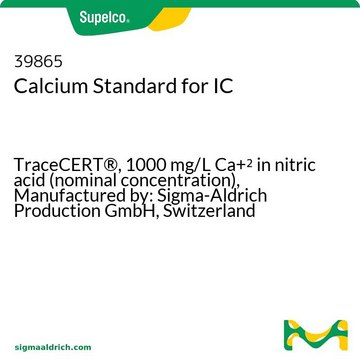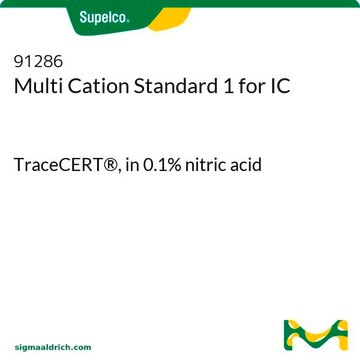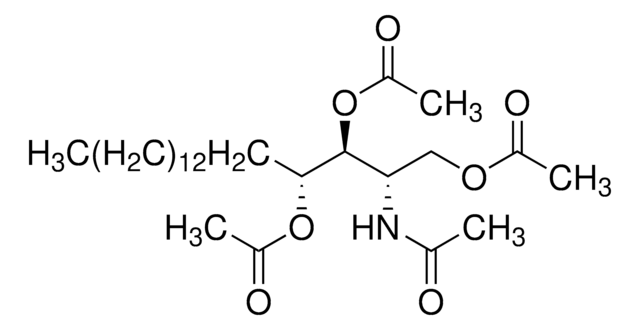所有图片(1)
About This Item
线性分子式:
CH3SO3H
CAS号:
分子量:
96.11
Beilstein:
1446024
MDL號碼:
分類程式碼代碼:
12161700
PubChem物質ID:
NACRES:
NB.21
推荐产品
一般說明
该离子色谱浓缩洗脱液通过电位滴定法测定浓度。含量和有效期请见证书。
應用
- Design of a new nanocomposite based on Keggin-type [ZnW(12)O(40)](6-) anionic cluster anchored on NiZn(2)O(4) ceramics: Explores the synthesis of advanced materials using Methanesulfonic acid, contributing to developments in energy storage and catalysis technology (Rezvani et al., 2024).
- Nanosuspensions in ophthalmology: Overcoming challenges and enhancing drug delivery for eye diseases: Discusses the role of Methanesulfonic acid in the formulation of nanosuspensions, enhancing therapeutic efficiency in ophthalmologic applications (Fathi-Karkan et al., 2024).
- Building Flame-Retardant Polymer Electrolytes via Microcapsule Technology for Stable Lithium Batteries: Methanesulfonic acid may be utilized in the synthesis of flame-retardant materials for safer lithium battery technologies, addressing critical needs in electronic manufacturing (Zhang et al., 2024).
- Catalysts for C-N coupling in urea electrosynthesis under ambient conditions from carbon dioxide and nitrogenous species: Highlights the application of Methanesulfonic acid in developing catalysts for green chemistry processes, particularly in the efficient synthesis of urea from environmentally benign sources (Yang et al., 2024).
聯結
请访问 IC 门户 了解更多
準備報告
由甲烷磺酸和高纯水(18.2MΩ,经 0.2μm 膜过滤)配制而成
儲存類別代碼
12 - Non Combustible Liquids
水污染物質分類(WGK)
nwg
閃點(°F)
Not applicable
閃點(°C)
Not applicable
個人防護裝備
Eyeshields, Gloves
其他客户在看
Chris Twelves et al.
Breast cancer research and treatment, 148(3), 553-561 (2014-11-09)
Data from two phase 3 studies of eribulin were pooled in analyses initially requested by the European Medicines Agency to assess whether specific patient subgroups, previously treated with an anthracycline and a taxane, benefited from eribulin. Study 305/EMBRACE included women
Neal W Sach et al.
Organic letters, 14(15), 3886-3889 (2012-07-18)
A general synthesis of aryl ethers from primary and secondary alcohols and aryl mesylates is presented. The reaction proceeds via a sulfonyl-transfer mechanism. In this paper, we compare the sulfonyl transfer reaction to Mitsunobu ether formation. The reaction can be
Solvejg Jørgensen et al.
Physical chemistry chemical physics : PCCP, 15(14), 5140-5150 (2013-03-02)
The gas phase reaction between methane sulfonic acid (CH3SO3H; MSA) and the hydroxyl radical (HO), without and with a water molecule, was investigated with DFT-B3LYP and CCSD(T)-F12 methods. For the bare reaction we have found two reaction mechanisms, involving proton
Norio Murai et al.
Organic letters, 14(11), 2818-2821 (2012-05-18)
A one-pot primary aminomethylation of aryl halides, triflates, mesylates, and tosylates via Suzuki-Miyaura cross-coupling reactions with sodium phthalimidomethyltrifluoroborate followed by deamidation with ethylenediamine is reported.
Cassandra J Gaston et al.
Environmental science & technology, 44(5), 1566-1572 (2010-02-04)
Dimethyl sulfide (DMS), produced by oceanic phytoplankton, is oxidized to form methanesulfonic acid (MSA) and sulfate, which influence particle chemistry and hygroscopicity. Unlike sulfate, MSA has no known anthropogenic source making it a useful tracer for ocean-derived biogenic sulfur. Despite
我们的科学家团队拥有各种研究领域经验,包括生命科学、材料科学、化学合成、色谱、分析及许多其他领域.
联系技术服务部门








